
The Boeotian helmet was a type of combat helmet used in Ancient Greece and Greek-influenced regions during the classical and Hellenistic periods, as well as in Ancient Rome; it possibly originated in the Greek region of Boeotia.

The Boeotian helmet was a type of combat helmet used in Ancient Greece and Greek-influenced regions during the classical and Hellenistic periods, as well as in Ancient Rome; it possibly originated in the Greek region of Boeotia.
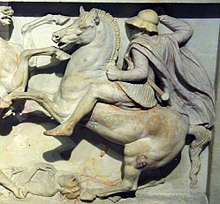
The Boeotian helmet was modelled on the shape of a folded-down Boeotian variant of the petasos , a type of Greek sun hat, usually made of felt. [1] As an open helmet, it allowed good peripheral vision and unimpaired hearing. It had a domed skull surrounded by a wide, flaring, down-sloping brim. The brim came down at the rear to protect the back of the neck, projected forward over the forehead and was worked into a complex shape at the sides, with downward pointing folds affording some lateral protection to the face. A long falling plume was sometimes attached to this type of helmet. The need for unimpeded vision and good hearing was particularly acute for cavalrymen, therefore this type of helmet was used primarily by mounted troops. [2]
This type of helmet was beaten from a single sheet of bronze using a helmet-shaped "former," one of which, made of limestone, is extant. An excellently-preserved example of a Boeotian helmet, which may have belonged to one of Alexander the Great's cavalrymen, was recovered from the Tigris River in Iraq, and is now in the Ashmolean Museum. In the late Hellenistic period, the helmet evolved into a type with a taller, more conical skull and often a reduced brim. [3]

The Athenian military expert and author Xenophon particularly recommended the Boeotian helmet for cavalry, saying "...the Boeotian type [of helmet]. For this not only gives the greatest protection to all the parts above the cuirass, but allows free vision." [4] This piece of advice was taken up by Alexander the Great, who equipped his cavalry with this helmet. [5] Both the Alexander Sarcophagus and the Alexander Mosaic show cavalrymen of the Ancient Macedonian army wearing Boeotian helmets. [6] As a specialised cavalry helmet, its use was not as widespread as some other ancient helmets such as the Corinthian or Phrygian types.
This helmet continued to be used by the successors of Alexander the Great, likely throughout the Hellenistic world, but is especially evident in the Greco-Bactrian and Indo-Greek kingdoms whose rulers often wore a variant of the helmet on coin depictions. [7] This was a very unusual and rare practice as most Hellenistic kings were shown wearing only the royal diadems on their coins.
The helmet was also used by Roman citizen cavalry in the Republican period. On the altar of Gnaeus Domitius Ahenobarbus (a consul in 122 BC), a Roman cavalryman is depicted wearing it with the later more conical skull and furnished with a falling horsehair plume.
The naming conventions and typology of ancient helmets are largely of modern origin and do not reflect contemporary usage. [8] The term "Boeotian helmet", however, is an exception since it was employed by Xenophon and is therefore of contemporary usage. Another piece of martial equipment linked to the region of Boeotia is the Boeotian shield; however, no surviving examples have been found, and its association with the region is largely through depictions on local coinage.

Boeotia, sometimes Latinized as Boiotia or Beotia, is one of the regional units of Greece. It is part of the region of Central Greece. Its capital is Livadeia, and its largest city is Thebes.
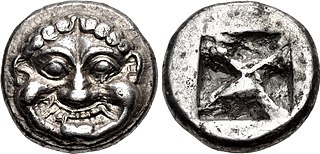
The history of ancient Greek coinage can be divided into four periods: the Archaic, the Classical, the Hellenistic and the Roman. The Archaic period extends from the introduction of coinage to the Greek world during the 7th century BC until the Persian Wars in about 480 BC. The Classical period then began, and lasted until the conquests of Alexander the Great in about 330 BC, which began the Hellenistic period, extending until the Roman absorption of the Greek world in the 1st century BC. The Greek cities continued to produce their own coins for several more centuries under Roman rule. The coins produced during this period are called Roman provincial coins or Greek Imperial Coins.

Thespiae was an ancient Greek city (polis) in Boeotia. It stood on level ground commanded by the low range of hills which run eastward from the foot of Mount Helicon to Thebes, near modern Thespies.

The Indo-Greek Kingdom, also known as the Yavana Kingdom, was a Hellenistic-era Greek kingdom covering various parts of modern-day Afghanistan, Pakistan and northwestern India.
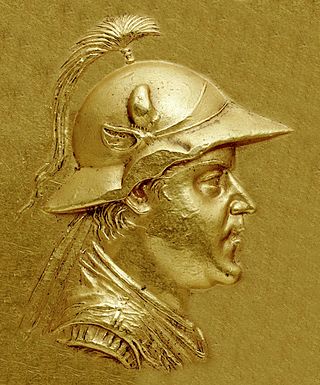
Eucratides I, also known as Eucratides the Great, was one of the most important Greco-Bactrian kings. He conquered large parts of northern India, and minted a vast and prestigious coinage, suggesting a rule of considerable importance and prosperity. His immediate successors were the last Greek kings to rule in Bactria.

A peltast was a type of light infantry originating in Thrace and Paeonia and named after the kind of shield he carried. Thucydides mentions the Thracian peltasts, while Xenophon in the Anabasis distinguishes the Thracian and Greek peltast troops.

A petasos or petasus (Latin) is a broad brimmed hat of Thessalian origin worn by ancient Greeks, Thracians and Etruscans, often in combination with the chlamys cape. It was made of wool felt, leather, straw or animal skin. Women's versions had a high crown while those for men featured a lower crown. It was worn primarily by farmers, travellers and hunters, and was considered characteristic of rural people. As a winged hat, it became the symbol of Hermes, the Greek mythological messenger god.

The sarissa or sarisa was a long spear or pike about 5 to 7 meters in length. It was introduced by Philip II of Macedon and was used in his Macedonian phalanxes as a replacement for the earlier dory, which was considerably shorter. These longer spears improved the strength of the phalanx by extending the rows of overlapping weapons projecting towards the enemy. After the conquests of Alexander the Great, the sarissa was a mainstay during the Hellenistic era by the Hellenistic armies of the diadochi Greek successor states of Alexander's empire, as well as some of their rivals.

Agathoclea Theotropus was an Indo-Greek queen married to Menander I, who ruled in parts of northern India in the 2nd-century BC as regent for her son Strato I. Born in Bactria, likely to a noble family with some authors such as Tarn alleging she was a daughter of Eucratides, however this is uncertain and Tarn is often criticised by modern authors for casually creating dynastic relationships. Nonetheless, Agathoclea would become one of the first woman ruler in the Hellenistic world, and she seems to have been relatively significant due to her large presence on the coins of Strato I.
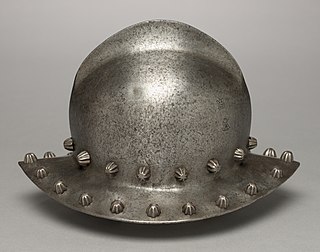
A kettle hat, also known as a war hat, was a type of combat helmet made of iron or steel in the shape of a brimmed hat. There were many design variations, with the common element being a wide brim that afforded extra protection to the wearer. It gained its common English language name from its resemblance to a metal cooking pot. The kettle hat was common all over Medieval Europe, and was called Eisenhut in German and chapel de fer in French.
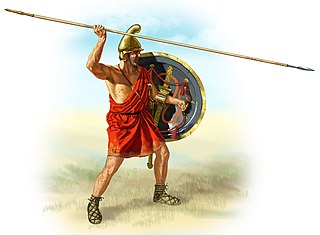
The Kingdom of Macedon possessed one of the greatest armies in the ancient world. It is reputed for the speed and efficiency with which it emerged from Greece to conquer large swathes of territory stretching from Egypt in the west to India in the east. Initially of little account in the Greek world, it was widely regarded as a second-rate power before being made formidable by Philip II, whose son and successor Alexander the Great conquered the Achaemenid Empire in just over a decade's time.
The kausia or causia was an ancient Macedonian flat hat. A purple kausia with a diadem was worn by the Macedonian kings as part of the royal costume.

Lobster-tailed pot helmet, also known as the zischägge, horseman's pot and harquebusier's pot, was a type of combat helmet. It was derived from an Ottoman Turkish helmet type. From c. 1600, it became popular in most of Europe and was especially worn by cavalrymen and officers. The helmet gradually fell out of use in most of Europe in the late 17th century; however, the Austrian heavy cavalry retained it for some campaigns as late as the 1780s.
The Hellenistic armies is a term that refers to the various armies of the successor kingdoms to the Hellenistic period, emerging soon after the death of Alexander the Great in 323 BCE, when the Macedonian empire was split between his successors, known as the Diadochi.

The Spartan army was the principle ground force of Sparta. It stood at the center of the ancient Greek city-state, consisting of citizens trained in the disciplines and honor of a warrior society. Subjected to military drills since early manhood, the Spartans became one of the most feared and formidable military forces in the Greek world, attaining legendary status in their wars against Persia. At the height of Sparta's power—between the 6th and 4th centuries BC—other Greeks commonly accepted that "one Spartan was worth several men of any other state."

The pileus was a brimless felt cap worn in Ancient Greece, Etruria, Illyria, later also introduced in Ancient Rome. The pileus also appears on Apulian red-figure pottery.
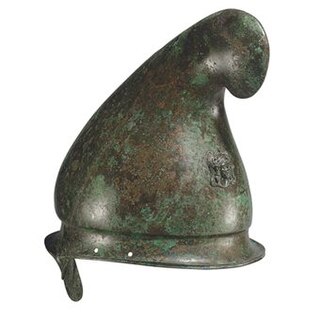
The Phrygian helmet, also known as the Thracian helmet, was a type of helmet that originated in ancient Greece, towards the close of the classical period and was used throughout the Hellenistic world until well into the period of the Roman Republic. Widely used by Greek, Macedonian, Diadochi, Italic peoples, Etruscans, Thracian, Phrygian and Dacian warriors throughout the Hellenistic and Roman republican period and by some ethnicities into Roman imperial times.
The Seleucid army was the army of the Seleucid Empire, one of the numerous Hellenistic states that emerged after the death of Alexander the Great.

The Greco-Bactrian Kingdom was a Greek state of the Hellenistic period located in Central Asia. The kingdom was founded by the Seleucid satrap Diodotus I Soter in about 256 BC, and continued to dominate Central Asia until its fall around 120 BC.

The first government of ancient Macedonia was established by the Argead dynasty of Macedonian kings during the Archaic period. The early history of the ancient kingdom of Macedonia is obscure because of shortcomings in the historical record; little is known of governmental institutions before the reign of Philip II during the late Classical period. These bureaucratic organizations evolved in complexity under his successor Alexander the Great and the subsequent Antipatrid and Antigonid dynasties of Hellenistic Greece. Following the Roman victory in the Third Macedonian War over Perseus of Macedon in 168 BC, the Macedonian monarchy was abolished and replaced by four client state republics. After a brief revival of the monarchy in 150–148 BC, the Fourth Macedonian War resulted in another Roman victory and the establishment of the Roman province of Macedonia.